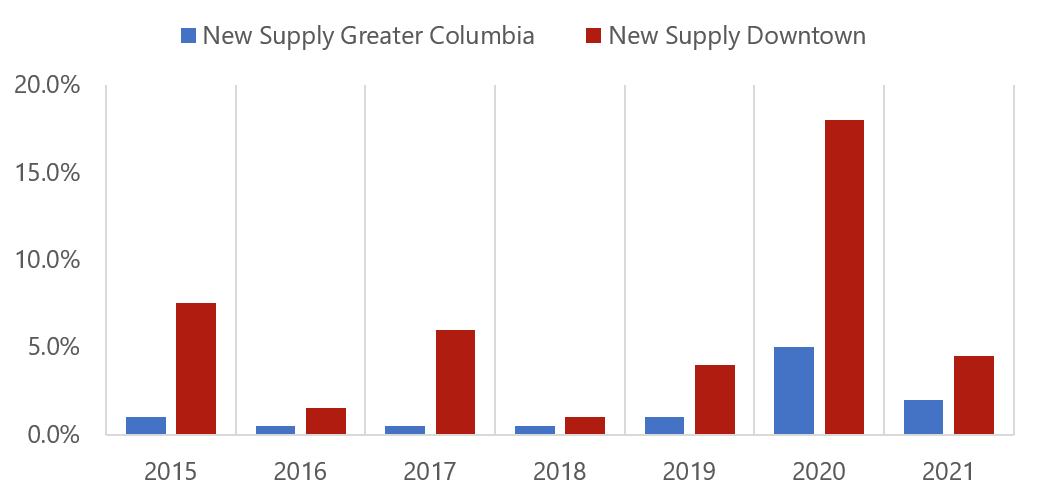 Source: By Salvationistdan - Own work, CC BY-SA 4.0,
Source: By Salvationistdan - Own work, CC BY-SA 4.0,
By McKenna Luke
Columbia, the state capital of South Carolina and the home of the University of South Carolina (USC), is a growing metroplex. Not only is the city expanding with notably annual population growth, the MSA population is expected to increase from roughly 800,000 to over 1,200,000 by 2045. The recent and current growth within the hospitality industry has been driven by growing population, visitation, new and expanding companies, and a pro-business environment. Fort Jackson remains a strong presence in the market, and over 100,000 family members attend basic-training graduation annually; several hoteliers in multiple submarkets within Columbia note that the graduation ceremonies are primary sources of demand. USC, which has an enrollment of almost 35,000 full-time students, drives hotel demand not only through the typical college events but also through providing an educate workforce and vibrant community that helps to attract new businesses.
Columbia is more than just a college town or a military town. Upon the stable foundations of the University of South Carolina, Fort Jackson, McEntire Joint National Guard Base, and the state capital, the economy continues to morph into a diverse and dynamic driver of hotel demand in the market. Nodes of growth within the manufacturing, distribution, energy, and professional service sectors support the continued success of hotels. Within the past twelve months, more than 300 jobs were created in Richland County, with over $265 million by private firms invested in just a dozen projects. A key project is the $77-million solar farm by Community Energy, which was announced in May 2019. Based on past solar projects and our interviews, the solar farms generate notable short-term, project-related business for many of the hotels. Furthermore, new sectors such as technology have been bolstered by projects such as the 181-acre BullStreet District, a redevelopment project that was announced in 2018. As South Carolina’s first urban gigabit community, it will offer walkable streets and a mix of residential, retail/restaurant, and recreational uses, while also creating 200 jobs as part of Capgemini’s offices in the mixed-used development. Furthermore, industrial and manufacturing developments are a solid foundation for the region, with a planned, 1,228-acre industrial park in Blythewood offering six million square feet of manufacturing, distribution, and mixed-use space proposed by Richland County. This steady economic growth and strength of the area’s employers continue to support the lodging industry.
Hotel revenue growth within the greater Columbia lodging market has been driven by average rate (ADR) gains, as occupancy has remained stable and in mid-60s for the past five years. New supply within the combined Lexington/Richland County market remained at roughly 0.5% from 2015 through 2018. The overall net new supply has been limited by several closures of older, functionally obsolete hotels or for conversions to other uses (Claussen Inn) or due to damage (a fire at the La Quinta on Two Notch Road). These closures have helped to mitigate the impact of new supply, which is opening in more desirable submarkets versus older submarkets such as Two Notch Road and Bush River Road. Most of the development has occurred within the hubs of new job growth, including the Downtown, Harbison, Lexington, and Cayce submarkets.
Downtown Columbia continues to emerge as a hotel market while serving as a catalyst for growth in the region. Containing only 13% of the hotel supply in 2014, while benefiting from notably higher performance (almost two times higher RevPAR) than the overall market, hotel developers have turned their investments toward the heart of Columbia. The addition of several hotels over the past five years has added roughly 250 rooms to date, an increase of over 15% since 2014. Nevertheless, Downtown’s lodging performance has remained strong, with RevPAR dipping only slightly in 2016.
However, the horizon for new supply has many hotel operators concerned that Columbia’s lodging metrics will begin to decline. Although new supply has averaged just under 2.0% on a national level, new supply in the greater Columbia market has been notably below this metric. Going forward, however, this trend is expected to reverse as new supply in the overall market is anticipated to top 5.0% next year, with the majority of the new rooms to open in Downtown. Furthermore, the submarket is expected to realize a whopping 18% increase in available room nights in 2020 alone.
A new tax incentive could buoy the market, with increased large, mixed-use developments creating new demand. In recent years, the development of large-scale projects, especially office, mixed-use, and residential, have been limited given the high costs of structured parking and the higher-than-typical property tax burden in Columbia. Realizing the need for public support for infrastructure development, the economic development offices of the City of Columbia and County of Richland announced the new commercial development incentive program in the summer of 2019. The incentive is a 50% property tax break, offered on a case-by-case basis for large, mixed-use projects of over $30 million, for ten years or the portion of the project costs related to public infrastructure, whichever comes first. This incentive could support projects that have been tabled in the past due to lack of feasibility and the unlikelihood of coming to fruition, and it is planned to continue until December 1, 2022. Although preliminary, almost a dozen proposals were sparked by the incentive within the first few weeks, and the overall impact could exceed $400 million, according to conversations with area officials.
This incentive, as well as the planned convention center expansion (100,000 square feet) and a new convention headquarters hotel, could elevate the city’s status. The convention center expansion and hotel would not only double the number of events that the center could accommodate but also would also attract new events that would not have considered the city before. Furthermore, the Columbia Metropolitan Airport continues to expand in its offering of direct service, including new flights to/from Miami and New York, for example; furthermore, the use of larger aircraft is another positive factor, contributing to an additional 60,000 seats. All of these economic prospects bode well for the market and the hotel industry, including hotel owners, operators, and investors in the region.



